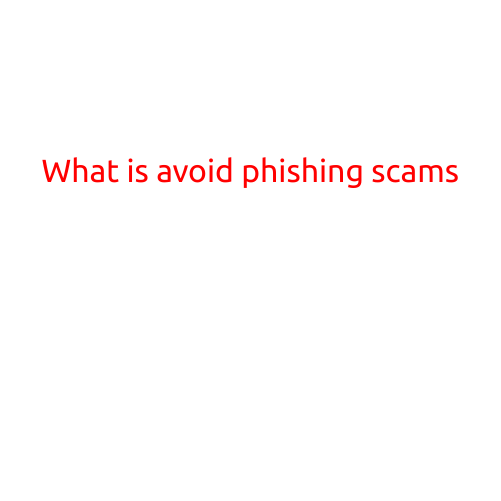
What is Avoid Phishing Scams
Phishing scams are a type of cybercrime that targets individuals and organizations by exploiting their trust and willingness to provide sensitive information. Phishing tactics have become increasingly sophisticated, making it crucial for people to be aware of the risks and take steps to protect themselves. In this article, we will explore what phishing scams are, how they work, and most importantly, how to avoid falling victim to these scams.
What is Phishing?
Phishing is a type of fraud in which attackers send fake emails, texts, or messages that appear to be from a legitimate organization, such as a bank, credit card company, or online retailer. The aim of these scams is to trick victims into revealing sensitive information, such as passwords, credit card numbers, or social security numbers.
How Do Phishing Scams Work?
Phishing scams typically involve several steps:
- Initial Contact: Scammers send an email, text, or message to their target, often with a catchy subject line or a sense of urgency.
- Fake Website: The scammer directs the victim to a fake website that looks identical to the legitimate website of the targeted organization.
- Username and Password: The victim is prompted to enter their username and password, believing they are logging into the legitimate website.
- Data Theft: The scammer captures the victim’s sensitive information, which can be used for illegal activities.
Types of Phishing Scams
There are several types of phishing scams, including:
- Email Phishing: Scammers send fake emails to trick victims into revealing sensitive information.
- Spear Phishing: Targeted phishing attacks aimed at specific individuals or groups, often involving sensitive information.
- Whaling: Phishing attacks aimed at high-level executives or celebrities, often involving substantial financial losses.
- Smishing: Phishing attacks via text messages.
How to Avoid Phishing Scams
To avoid falling victim to phishing scams, follow these best practices:
- Be Cautious: Be wary of emails, texts, or messages that ask for sensitive information or seem too good to be true.
- Verify: Check the website’s URL and ensure it begins with “https” (not just “http”) to indicate a secure connection.
- Use Antivirus Software: Install and regularly update antivirus software to detect and block phishing attempts.
- Monitor Accounts: Regularly monitor your accounts and transaction history for suspicious activity.
- Avoid Clicking Unknown Links: Do not click on links from unknown senders, as they may lead to malware downloads or fake websites.
- Use Strong Passwords: Use unique and strong passwords for all accounts, and consider using a password manager.
- Report Suspicious Activity: Report suspicious emails, texts, or messages to the relevant authorities or your internet service provider.
Conclusion
Phishing scams are a serious threat to individual and organizational security. By understanding how phishing scams work and taking steps to avoid them, you can significantly reduce your risk of falling victim to these scams. Remember to be cautious, verify information, and regularly monitor your accounts to stay protected from phishing attempts.





